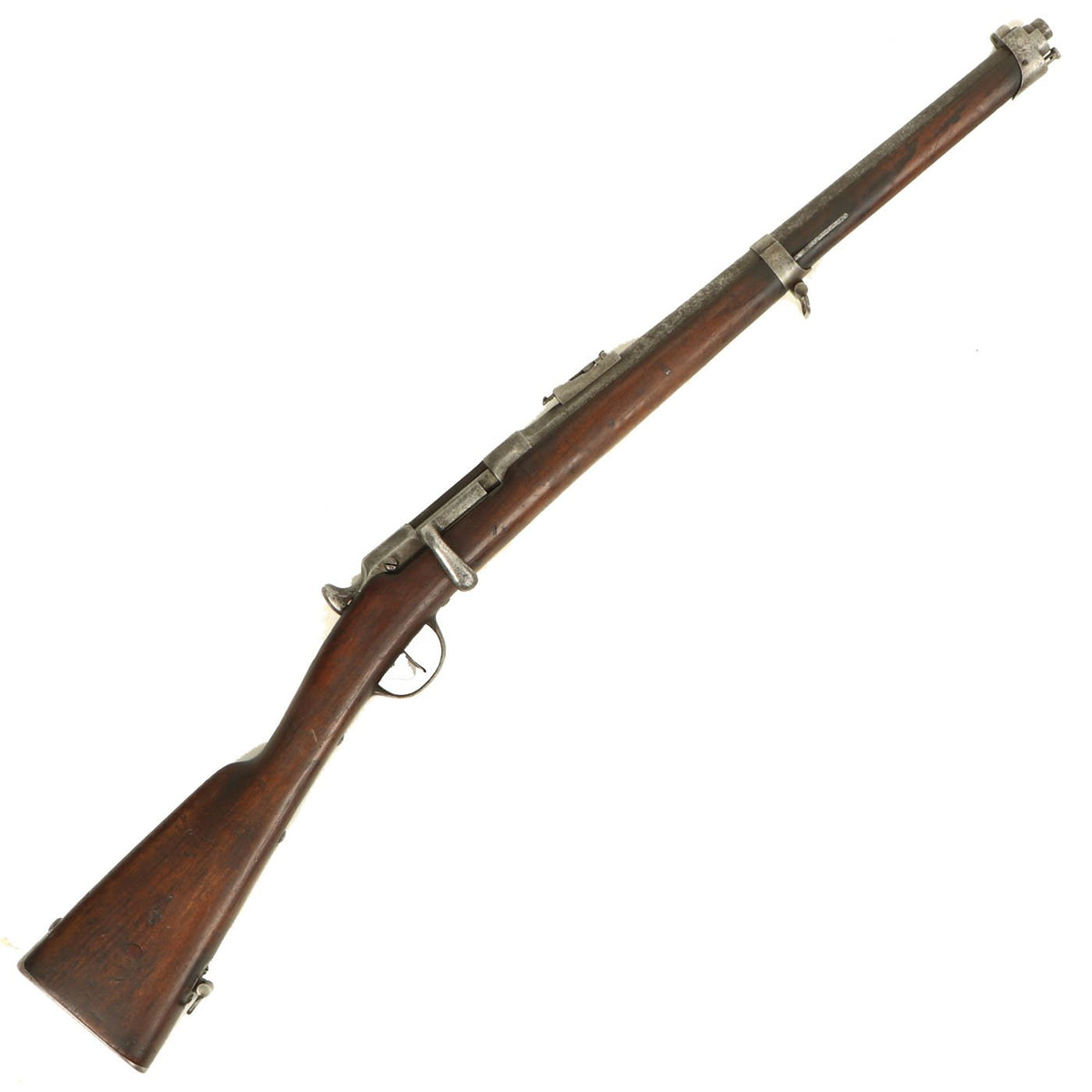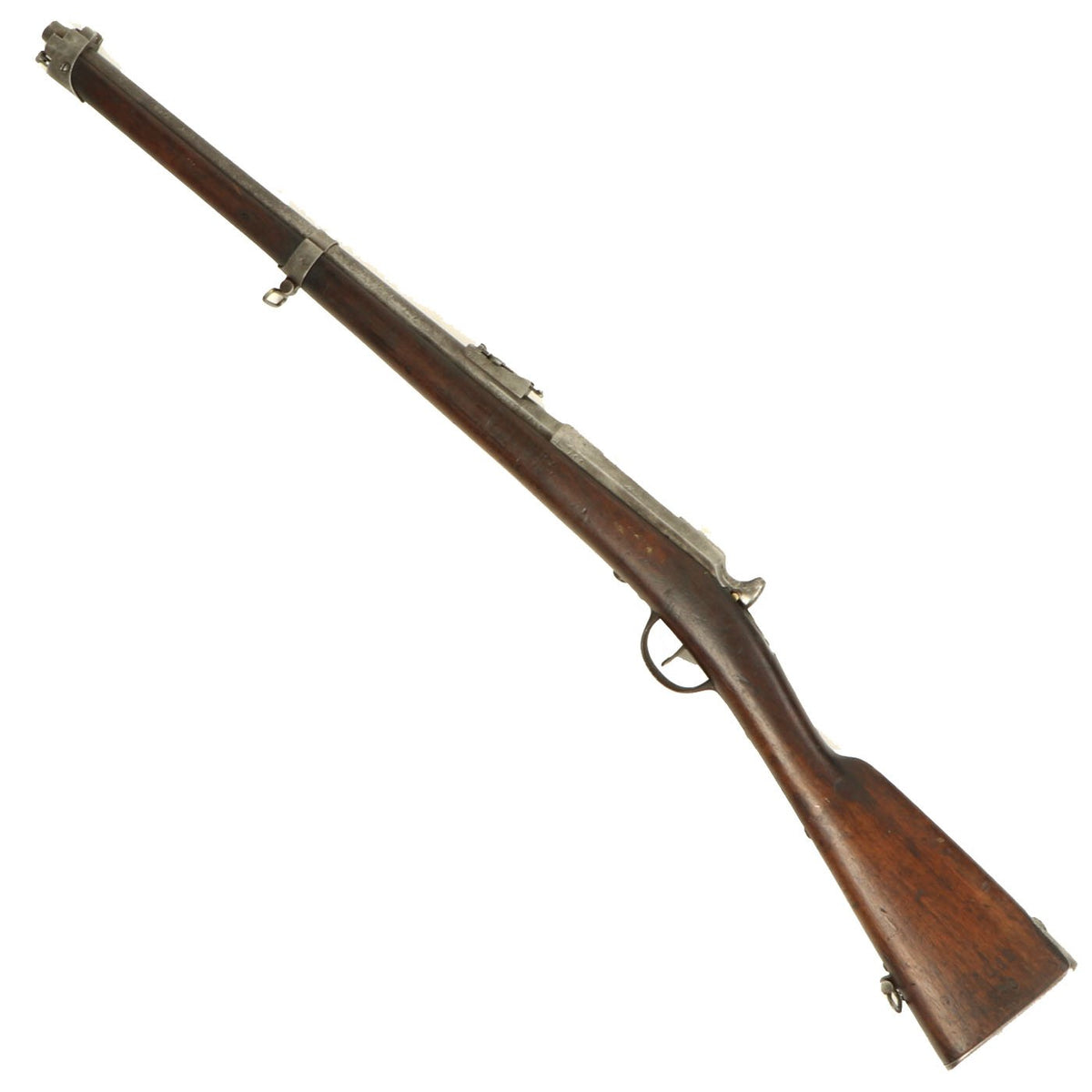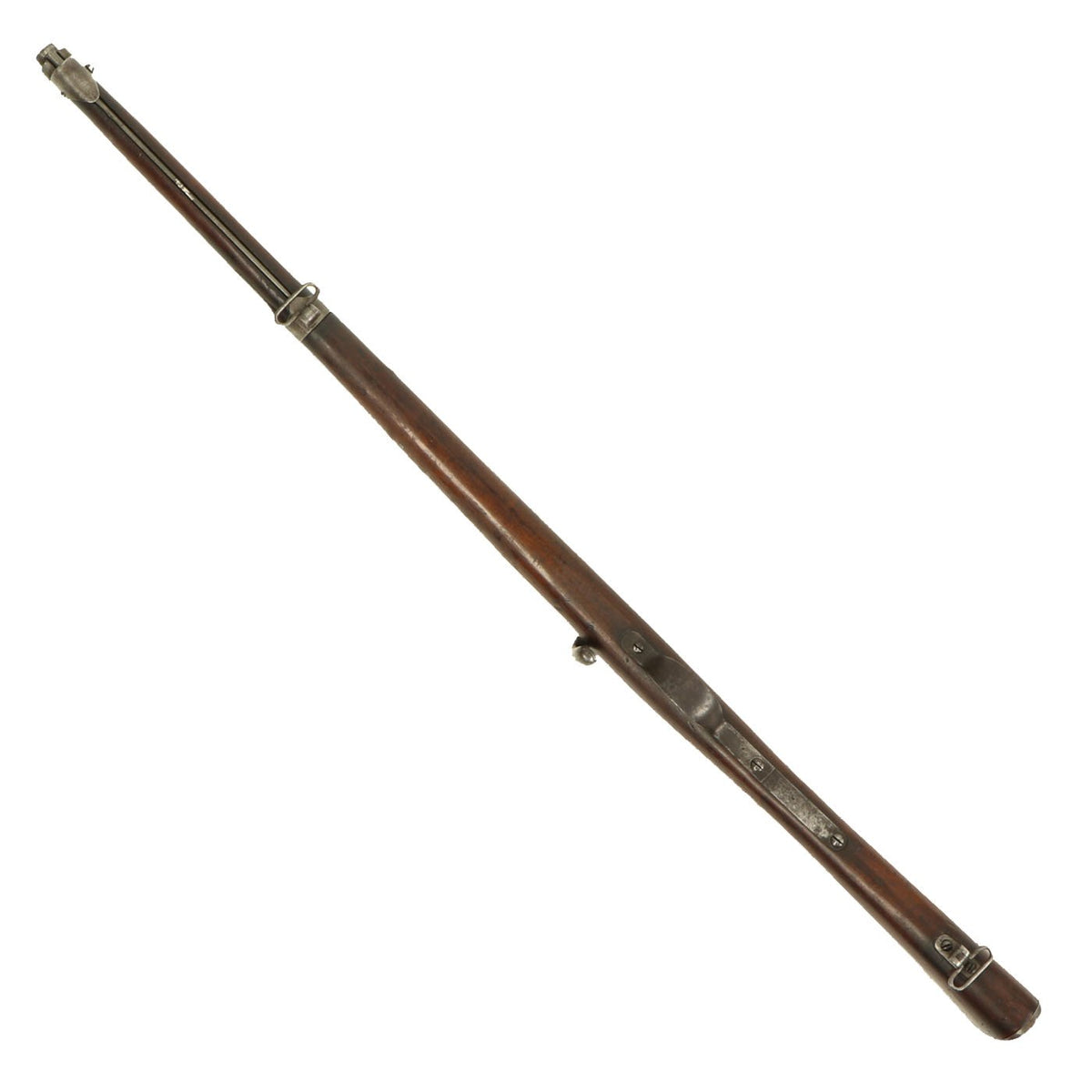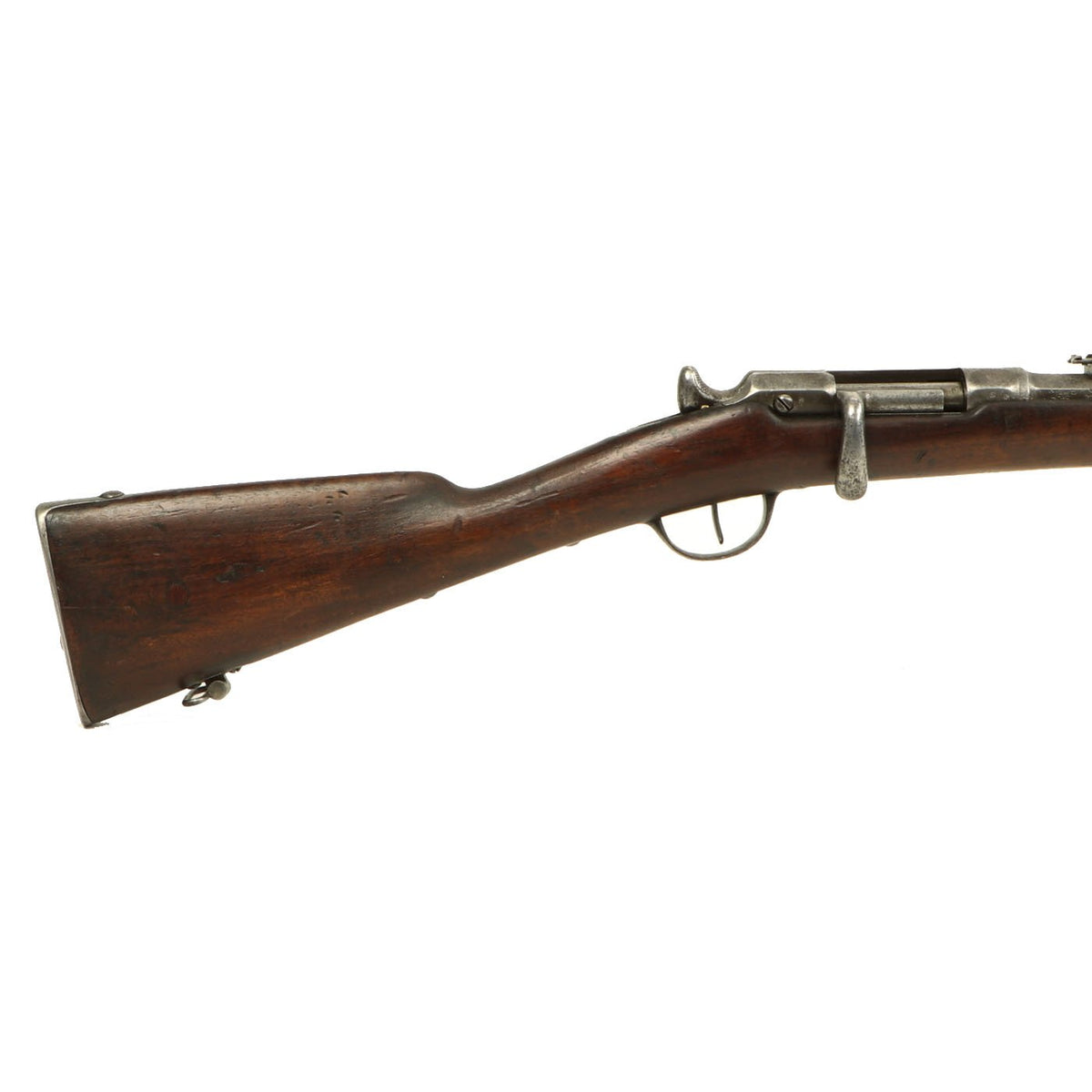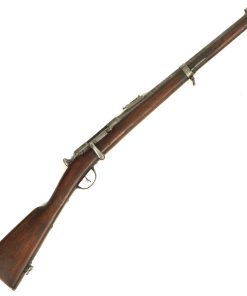Original French Fusil Modèle 1866 Chassepot by Mutzig Captured by Germany and Converted to Carbine Original Items
$ 1.895,00 $ 473,75
Original Item: Only One Available. Despite the fact that the French needle fire Chassepot rifle was far superior to the needle fire Prussian Dreyse rifle, the French took a swift and decisive beating in the war of 1870-71. In fairness to the French, the defeat was due to Napoleon III’s foolhardiness in allowing himself to get captured at the Battle of Sedan and the show was then over.
During and after the conflict, about 665,000 Chassepot rifles had been captured by the German coalition that defeated France in 1871. Large numbers of these captured Chassepot rifles were shortened and converted to 11 mm Mauser metallic cartridge. This involved converting the bolt to “bolt action” without requiring manual cocking. It served with cavalry units of the Kingdom of Saxony and of the Kingdom of Bavaria. This is one such converted carbine, and it is one of the first that we have had.
The Chassepot rifle of 1866 was a single shot bolt-action rifle and was among the best of it’s kind in 1866. It was quickly surpassed, principally by the British Martini-Henry, and was obsoleted in 1874 with the introduction of the metallic cartridge Gras Rifle that was in turn superseded in 1886 with the Lebel Rifle.
Our example here is a real treat, from a very hard to find maker! The rifle is very faintly marked M. on the nocks form, however even with a 16x magnifier we cannot make out a date. However it must have been made prior to the Franco Prussian war, so it only could have been made between 1866 and 1870. The carbine is also marked on the receiver with MLE 1866. to the right of the manufacturer information:
MANUFACTURE IMPÉRIALE
Mutzig
This is the marking for Manufacture Impériale de Mutzig (also known as Manufacture d’Armes de Mutzig), the Imperial Arsenal in the French town of Mutzig, located in the Château des Rohan (The Castle of Rohan). The castle’s history dates back to the 13th century, and after the French revolution, it became a small arms factory, as the castle was disowned by the Rohan family and pillaged during the conflict. In 1799, it was bought by the arms manufacturers, brothers Coulaux of Klingenthal, Bas-Rhin, who, on April 20 1801, opened their weapons factory in its walls. It was at this factory that a native of Mutzig, Antoine Alphonse Chassepot, fabricated some of his famous rifles, one of the most advanced firearms of its time. Unfortunately, Mutzig is located in the often-contested eastern region of France, Alsace-Lorraine. Due to this the arsenal stopped producing in 1869, so all Chassepot rifles by this maker are extremely rare. This region was captured by Germany in 1871 after the Franco-Prussian war, and not returned until after WWI. Given the early manufacture on this rifle, it is likely that Chassepot himself was involved with its manufacture.
The rifle has various serial numbers stamped on it, most likely from after capture by Germany. It looks to be serial number 948, which is stamped on the barrel, receiver, and bolt. However the number 80062 also appears on the barrel and bolt, stamped over other markings. These numbers also appear on the left butt stock, though they are faded.
The carbine is marked on the butt plate with a German Regimental designation: 5. R. U. 1. 57, along with other markings. The stylized “R” indicates it was issued to a Reserve regiment, so this would be for the 5th Reserve Uhlan Cavalry, 1st battalion, 57th Weapon. This is exactly correct for this carbine.
The action cycles, though it is worn, and the notch that holds the bolt in the cocked position is worn, so it needs to be cocked manually. Also when the bolt opened, it falls off this position, and will need to be manually reset. It does cock and dry fire when operated this way. The bore of the barrel is in fact in very good condition, with a mostly bright finish and clear lands and grooves. It does not show much sign of having been fired in service for either France or Germany.
The rifle bears both French and German issue markings. These are present on most of the metal components of the rifle, which have a lovely aged gray patina, with and light pitting throughout the exterior surfaces. The stock is in good used condition, showing possible arsenal refinishing, or just a lot of wear. The right side stock cartouche is completely worn.
This is a wonderful and unique example of a rare ignition system making it a rare and sought antique rifle. Being captured by Germany and put into service there as a carbine just adds to the romance! Ready to add to your collection and display!
Specifications-
Year of Manufacture: 1866-1870
Caliber: 11 mm Mauser
Ammunition Type: Centerfire Cartridge
Barrel Length: 20 1/2 Inches
Overall Length: 39 1/4 Inches
Action: Bolt-Action
Feed System: Single Shot
NOTE: International orders of antique firearms MUST be shipped using UPS WW Services (courier). USPS Priority Mail international will not accept these.
Fast Shipping with Professional Packaging
Thanks to our longstanding association with UPS FedEx DHL, and other major international carriers, we are able to provide a range of shipping options. Our warehouse staff is expertly trained and will wrap your products according to our exact and precise specifications. Prior to shipping, your goods will be thoroughly examined and securely secured. We ship to thousands clients each day across multiple countries. This shows how we're dedicated to be the largest retailer on the internet. Warehouses and distribution centres can be located throughout Europe as well as the USA.
Note: Orders with more than one item will be assigned a processing date depending on the item.
Before shipping before shipping, we'll conduct a thorough inspection of the items you have ordered. Today, the majority of orders will be delivered within 48 hours. The delivery time will be between 3-7 days.
Returns
The stock is dynamic and we cannot completely manage it because multiple stakeholders are involved, including our factory and warehouse. So the actual stock may alter at any time. It's possible that you may not receive your order once the order has been made.
Our policy is valid for a period of 30 days. If you don't receive the product within 30 days, we are not able to issue a refund or an exchange.
You can only return an item if it is unused and in the same state as the day you received it. You must have the item in its original packaging.
Related products
Uncategorized
Uncategorized
Uncategorized
Uncategorized
Uncategorized
Uncategorized
Uncategorized
Australian WWII Owen MK1 Machine Carbine SMG Custom Fabricated Replica with Sling Original Items
Uncategorized
Armoured Fighting Vehicles of the World: AFVs of World War One (Hardcover Book) New Made Items
Uncategorized
Armored Burgonet Helmet & Polearm from Scottish Castle Leith Hall Circa 1700 Original Items
Uncategorized
Angolan Rebel 1970s era 60mm Inert Display Mortar from Angolan Civil War Original Items
Uncategorized
Uncategorized
Uncategorized
Uncategorized
Uncategorized
Uncategorized
Uncategorized
Uncategorized
Band of Brothers ORIGINAL GERMAN WWII Le. F.H. 18 10.5cm ARTILLERY PIECE Original Items
